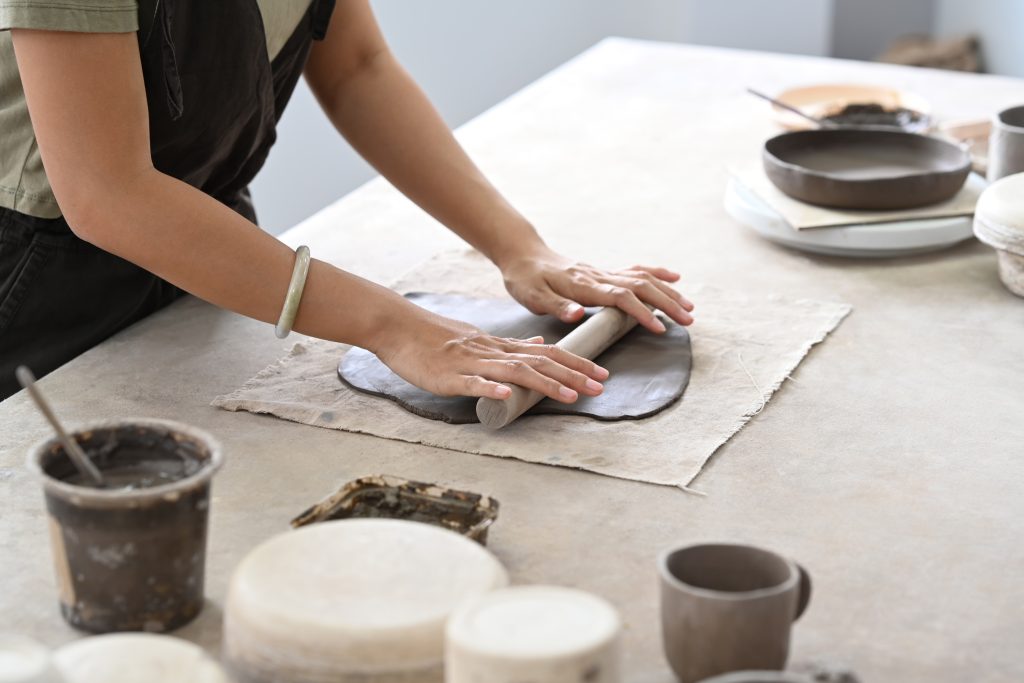
Making your own ceramic plates can be a rewarding and therapeutic process. It allows you to express your creativity while creating functional pieces for your home. One of the most effective methods for beginners is the stick and slab technique. Here’s a comprehensive, step-by-step guide on how to make your own ceramic plates using this method.
Step 1: Gather Your Materials
To start, gather all the necessary materials. You will need clay, a rolling pin, wooden sticks (about 1/4 inch thick), a clay knife or wire cutter, a plaster bat (a flat surface for drying), and a round template for your plate size.[1]
Step 2: Roll Out Your Clay
Begin by wedging your clay to remove any air bubbles. Place the wooden sticks on either side of your clay slab and use the rolling pin to roll out the slab. The sticks will ensure that the slab is of uniform thickness.[1]
Step 3: Cut Out Your Plate
Once your clay slab is rolled out, place your round template on top and use your clay knife to cut around it. Remove the excess clay and smooth the edges with a sponge or your fingers.[1]
Step 4: Shape Your Plate
Next, lift the cut-out slab and gently place it on a plaster bat. The bat should be slightly concave to give the plate its shape. Press the slab into the bat, ensuring it takes the shape of the plate.[1]
Step 5: Dry and Bisque Fire
Leave your plate on the plaster bat to dry. This may take several days, depending on the thickness of your slab and the humidity in your area. Once completely dry, it’s time for the first kiln firing, known as bisque firing. This hardens the clay and prepares it for glazing.[1]
Step 6: Glaze and Glaze Fire
After bisque firing, apply your chosen glaze to the plate. Be careful not to apply glaze on the bottom of the plate, as it can stick to the kiln shelf. Once the glaze is dry, it’s time for the final step: glaze firing. This firing will give your plate a glassy finish and make it food-safe.[1]
Creating ceramic plates using the stick and slab technique is a fantastic way to delve into the art of pottery. It’s more than just a craft; it’s a means of expression, a way to create something truly unique. If you’re a person who wants to design a retirement plan that lets you explore hobbies like this one when you retire, Click HERE to reach out to our professionals at Bulman Wealth Group for a complimentary review of your retirement strategy.
All content is for information purposes only. It is not intended to provide any tax or legal advice or provide the basis for any financial decisions. Nor is it intended to be a projection of current or future performance or an indication of future results.
Opinions expressed herein are solely those of Chris Bulman Inc. dba Bulman Wealth Group and our editorial staff. The information contained in this material has been derived from sources believed to be reliable but is not guaranteed as to accuracy and completeness and does not purport to be a complete analysis of the materials discussed. All information and ideas should be discussed in detail with your individual advisor prior to implementation. Investment advisory services are offered through Chris Bulman Inc dba Bulman Wealth Group, an SEC Registered Investment Advisor. Insurance products and services are offered through Chris Bulman, Inc. dba BWG Insurance Agency and Ameritas Life Insurance Corp., CA State Insurance License # 0M46922. Being registered as an investment advisor does not imply a certain level of skill or training.
Bulman Wealth Group, BWG Insurance Agency and Ameritas Life Insurance Corp. are not affiliated with or endorsed by the Social Security Administration or any other government agency.
Any statements or opinions expressed should in no way be construed or interpreted as a solicitation to sell, or offer to sell, advisory services to any residents of any State other than the States where otherwise legally permitted.
Images and photographs are included for the sole purpose of visually enhancing the website. None of them are photographs of current or former Clients. They should not be construed as an endorsement or testimonial from any of the persons in the photograph.
Purchases are subject to suitability. This requires a review of an investor’s objective, risk tolerance, and time horizons. Investing always involves risk and possible loss of capital.








